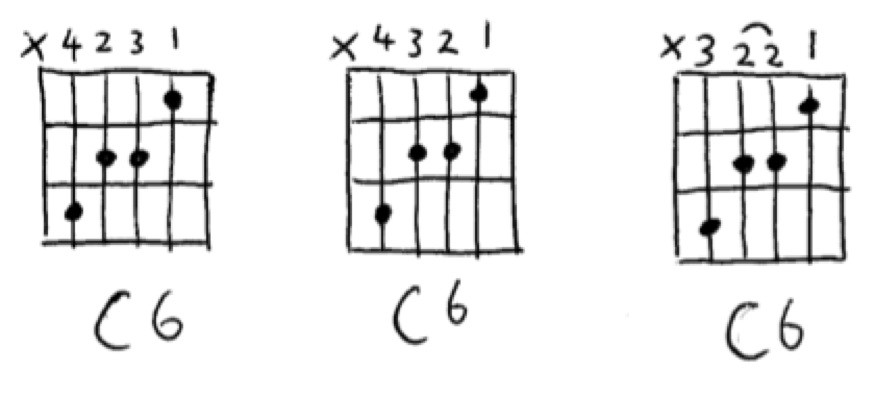The C6 chord is a versatile and colorful chord in guitar music. While there are numerous ways to play a C6 chord across the fretboard, some shapes are more practical and user-friendly than others. For guitarists already familiar with the open C chord, learning a C6 shape that builds upon this foundation is a logical and efficient step. This article explores a common and accessible C6 Chord Guitar shape, along with variations to suit different playing styles and musical contexts.
Exploring Practical C6 Chord Guitar Fingerings
Many guitarists find it easiest to learn C6 chord shapes that are close to familiar open chords. The following diagrams illustrate three effective fingerings for a C6 chord, all centered around a shape reminiscent of the open C and Am chords.
 C6 chord guitar fingerings diagram. Three shapes for playing the C6 chord on guitar, including variations using barre and finger strength.
C6 chord guitar fingerings diagram. Three shapes for playing the C6 chord on guitar, including variations using barre and finger strength.
Let’s break down each of these C6 chord guitar fingerings:
Fingering 1: The Am Shape Variation
This first C6 chord fingering will feel instantly familiar if you know the Am chord. It essentially starts with an Am shape, but with the 4th finger added to fret 3 of the 5th string (A string). This added note is the root note C, creating a C in the bass and transforming the Am-like shape into a C6.
Fingering 2: Meaningful Username’s C6 Chord
The second fingering, attributed to “Meaningful Username” in the original discussion, offers another valid approach. While not explicitly detailed here without the original context, it represents a slightly different way to achieve a C6 voicing, likely focusing on simplicity and ease of transition from other common chords. (Note: Without further detail on “Meaningful Username’s” suggestion, we maintain the reference but focus on the other more clearly described fingerings).
Fingering 3: The Barre-ish C6 Chord
The third fingering introduces a mini-barre technique. The 2nd finger is used to barre across the 2nd fret of both the 3rd and 2nd strings (G and B strings). This technique, while requiring a bit more finger strength and practice, offers a significant advantage. The remaining part of the chord then becomes essentially a regular C major shape. This similarity to the standard C chord makes transitioning between C, C6, and C7 chords smoother, which is particularly useful in songs that utilize these chord changes.
Understanding the C6 Chord Voicing
It’s worth noting that the C6 chord shapes presented here are slightly simplified voicings. Specifically, they omit the 5th of the C6 chord, which is the note G. In music theory, this means these shapes technically function more like an Am/C chord (Am chord with a C bass note).
However, in practical guitar playing and in many musical contexts, this omission is often insignificant. The overall sound still strongly conveys the character of a C6 chord. The absence of the G note doesn’t dramatically alter the harmonic color, and these shapes remain highly effective and commonly used as C6 chords.
Chord Charts and Practical Application
It’s important to remember that lyric sheets with chord symbols, like the one mentioned in the original context, are not always precise guides to the ideal chord voicings. They primarily indicate the intended harmony, not necessarily the specific guitar shapes that will sound best or be easiest to play. Furthermore, informally published music sources may not always be entirely accurate.
Therefore, while chord charts provide a valuable starting point, experimenting with different C6 chord guitar shapes, like the ones presented here, is crucial for finding the best sound and playability for a given song. The C6 shapes described in this article are practical options that should work effectively in a wide range of musical situations, offering both a pleasing sound and comfortable playability for guitarists.
